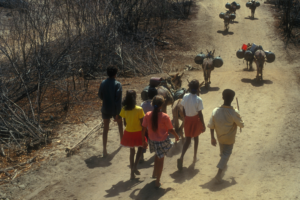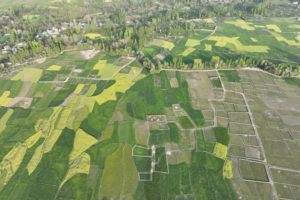World Population Day: Why we should still be concerned about human population growth
WriWorld Population Day: Why we should still be concerned about human population growth July 11 is World Population Day, a United Nations observance day first marked in 1990 to raise awareness of the urgency and importance of population issues. Concern about the impacts of rapid population growth on the environment and poverty alleviation efforts used to be widespread, leading to many successful voluntary family planning programs. Despite our population having grown by an additional 3 billion people since 1990, to 8 billion and counting today, mainstream news now gives the impression that overpopulation concern has, absurdly, been replaced with underpopulation concern. Media stories about declining birth rates abound, leading many to mistakenly assume that our global population has already stopped growing. Some even believe we are on the verge of a catastrophic “population collapse” due to growth-obsessed influencers like Elon Musk sowing “baby bust” panic. This is completely untrue. The most authoritative population projections by the United Nations Population Division, updated today, reveal we are still on track for a peak population of more than 10 billion people in the 2080s. An earlier, lower peak is within reach through globally beneficial means, however. Here’s why we urgently need to work towards this goal. Wherever women have access to the full range of reproductive health services and are free to pursue education and career opportunities, fertility rates drop to or below the replacement level of 2.1 births per woman. The countries with the highest fertility rates are generally those with the worst gender equality scores – where women have no say over what happens to their bodies and lives and where child marriage and teen pregnancy are prevalent. The fact that our global population is still growing is a result of our failure to end these injustices and liberate all women and girls from the most harmful patriarchal customs. We cannot meet climate targets by focusing only on the consumption side of the equation, especially as global consumption growth is increasingly a result of people in lower- and middle-income countries attaining a higher quality of life. A comprehensive analysis of all available climate solutions by Project Drawdown concluded that slowing population growth represents the third most effective action, after reducing food waste and adopting plant-based diets, in terms how much emissions it would prevent by 2050 in line with limiting global temperature rise to 2˚C. Even more important than the mitigation potential of empowering population solutions is their adaptation potential. Many of the most rapidly growing countries, such as those in the Sahel, are facing the worst climate change impacts. This is a recipe for disaster, with hundreds of millions of children at risk of being exposed to extreme water stress, food insecurity, and natural disasters. A 2019 comment in the journal Nature described the Sahel as a “powder keg” for these reasons, calling on governments to “avert catastrophe” by urgently investing in family planning and girls’ education. A 2023 report by the Population Institute adds to this call, finding that in the 80 most climate-vulnerable countries, population is growing on average at twice the global average rate, while in a dozen of these countries, it’s growing more than three times as fast. Enabling women in these nations to determine the number and timing of their children will allow families to be better prepared for hard times, and will reduce the number of people exposed to climate disasters. When more women are able to access education and enter the labor market, this also helps accelerate countries’ economic development. A higher proportion of women in decision-making is proven to lead to more policies that benefit the environment and people, and to make peace negotiations less likely to fail. All of this helps build resilience to climate change as well as other shocks, such as pandemics. Environmental discourse is nowadays heavily focused on the climate crisis, but there is another environmental crisis on par with climate change in terms of the existential risk it presents: the alarming loss of biodiversity. Biodiversity, the variety of life on Earth, is key to the healthy functioning of ecosystems which provide us with all basic necessities, such as fresh water, food, and shelter. An estimated one million species are facing extinction due to human activity – primarily as a result of habitat destruction and overexploitation of nature. While the relationship between human population growth and climate change is complex due to wealth inequalities, the link between population and biodiversity is pretty straightforward: ever more humans means ever less wildlife. While the movement of people from rural to urban areas can help decrease pressure on remaining wilderness, we are still using almost half of all habitable land for agriculture. Meeting the demands of 10 billion people with a decent quality of life will require appropriating even more land and resources for human uses. A lot of the resistance to addressing population growth stems from fear of being associated with coercive population policies of the past, such as China’s one-child policy and India’s mass sterilization campaigns. These represented human rights violations and were completely unnecessary – we know now that the most effective way to slow population growth is by expanding reproductive rights and bodily autonomy, not restricting them. It is possible and necessary to discuss population in a way that prioritizes human rights and personal freedoms. An estimated 218 million women in lower- and middle income countries have an unmet need for modern contraception. The Guttmacher Institute estimates that fulfilling this unmet need would cost just $10.60 per person per year. Considering its incredibly broad benefits, removing barriers to family planning undoubtedly represents one of the most cost-effective sustainable development interventions out there. It’s high time we give it the attention and investment it deserves.Continued population growth reflects stagnating progress on gender equality
The fastest growing areas are the most vulnerable
 Drawing links between population growth and climate change is often seen as contentious, because the fastest growing populations tend to be the poorest, with the smallest carbon footprints. Wealthy countries absolutely bear the most responsibility for the historical emissions that have precipitated the climate crisis and thus have a moral obligation to lead on mitigation and adaption efforts. Nevertheless, according to the Intergovernmental Panel on Climate Change (IPCC), both consumption and population growth “remain the strongest drivers CO2 emissions from fossil fuel combustion.” India, for example, despite still having relatively low per capita emissions, is the third biggest national emitter after China and the United States, respectively.
Drawing links between population growth and climate change is often seen as contentious, because the fastest growing populations tend to be the poorest, with the smallest carbon footprints. Wealthy countries absolutely bear the most responsibility for the historical emissions that have precipitated the climate crisis and thus have a moral obligation to lead on mitigation and adaption efforts. Nevertheless, according to the Intergovernmental Panel on Climate Change (IPCC), both consumption and population growth “remain the strongest drivers CO2 emissions from fossil fuel combustion.” India, for example, despite still having relatively low per capita emissions, is the third biggest national emitter after China and the United States, respectively.Our numbers are squeezing out biodiversity
 In countries where individual consumption levels are low, population growth is often the biggest driver of biodiversity loss. An Africa-wide assessment published in Nature Scientific Reports in 2019, for example, found that human population density was the most important socioeconomic predictor of environmental degradation, and a 2018 study published in Science Advances found that 84 percent of the forest loss in the Congo Basin between 2000 and 2014 was due to subsistence farming and clearing for charcoal production by local communities.
In countries where individual consumption levels are low, population growth is often the biggest driver of biodiversity loss. An Africa-wide assessment published in Nature Scientific Reports in 2019, for example, found that human population density was the most important socioeconomic predictor of environmental degradation, and a 2018 study published in Science Advances found that 84 percent of the forest loss in the Congo Basin between 2000 and 2014 was due to subsistence farming and clearing for charcoal production by local communities.Bringing population back on the table

